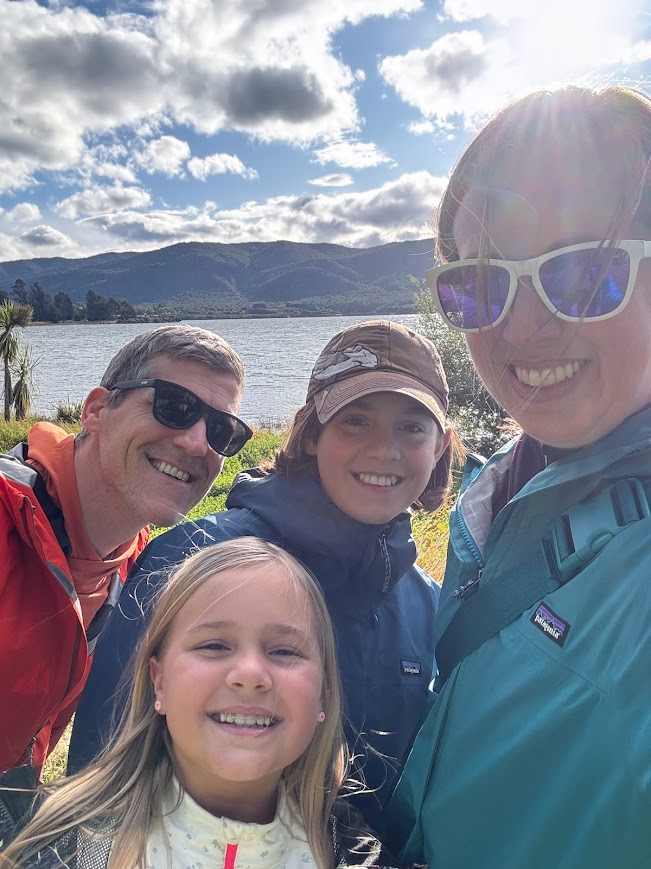Selcouth Chronicles Week 4
Hello family and friends - it's week 4 of the Selcouth Chronicles!
Week 4: January 28nd - February 3rd
🛫Jan. 31 Singapore ->Feb.1 Auckland 🛬
🛫Feb. 1 Auckland ->Queenstown 🛬
🚗Feb. 2 Queenstown->Te Anau
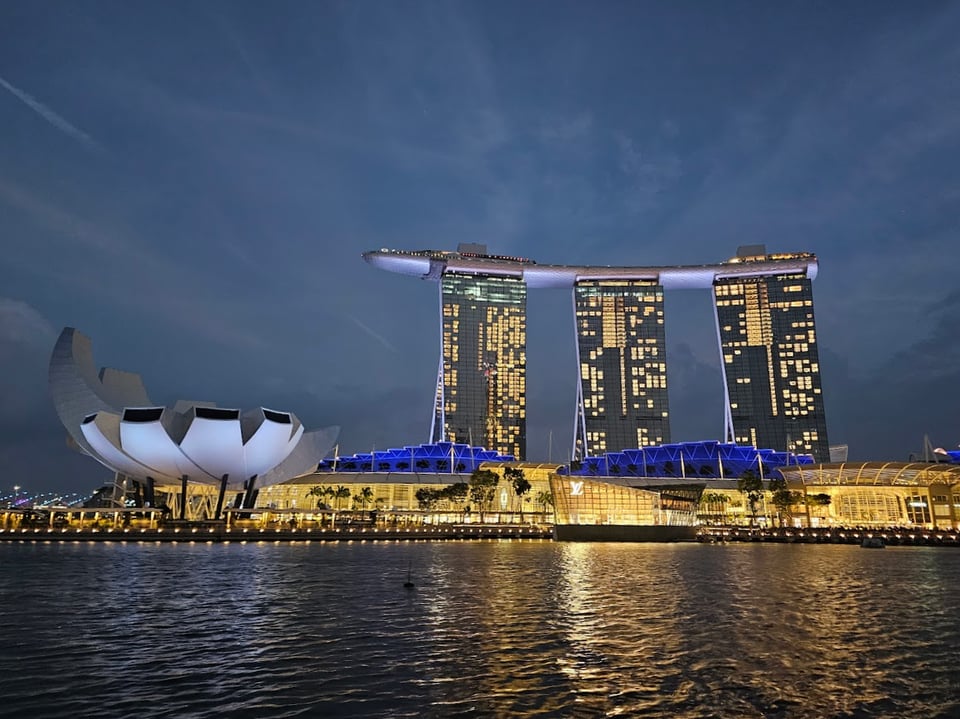
SINGAPORE and NEW ZEALAND
Highlights: Cruising Singapore harbor in a bumboat, Singapore Botanic Gardens, Fort Canning, Changi Airport, Glowworm Caves
Abby:
Hello! This time I’m doing the weekly recap.
This week we headed out of Singapore and into our 3 week visit to New Zealand. We closed up Singapore with Monday, Tuesday, and half of Wednesday. Monday, we river cruised Singapore harbor, taking in the sites of the city. Tuesday, we went to the beautiful Singapore Botanical Gardens. We marveled at many plants & enjoyed the Orchids at the Orchid Gardens. After that, we went to Raffles Long Bar, the signature place to get a Singapore Sling. Mom and Dad got the Singapore Slings while James & I got “TeeTotalers Sling” (aka the World’s Best Shirley Temples!😂).
Wednesday, we went to Fort Canning Park, where we visited the Battlebox. (James will explain that.) Afterwards, James & I had fun playing at Jubilee Park - the name explains it all!
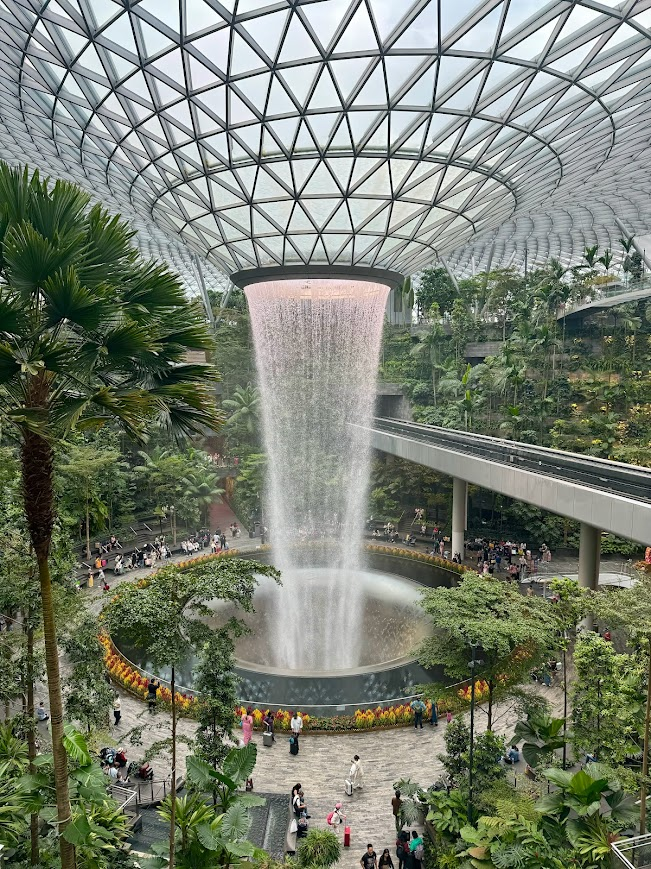
Towards the afternoon, we headed to the amazing Changi Airport to fly to New Zealand. Changi Airport was quite entertaining, James & I had lots of fun playing at the Hedge Maze, the Mirror Maze, Bouncing Net, and Walking Net. Changi Airport, as you can tell, is MUCH more fun and different than other airports! We had a nice plane ride, because Mom and Dad used all of our flight points to get us on Business Class. It was an overnight flight and we could recline our seats flat and we got to eat fancy meals!

The connecting flight was fine, even though it was only economy!😋 Our stop in Queenstown was quite uneventful, but pretty. After a quick stop there, we headed to Te Anau. We had a yummy lunch at Sandfly Cafe, went grocery shopping (finally), and ended the day with an entertaining Bird Sanctuary. The day after, we had a wonderful stop at a glowworm cave.
Overall, week #4 of our journey was a blast.
Best wishes to my dearly missed class and friends!😘
Sean:
The swirling waters of our journey took us to Te Anau in the southern island of New Zealand. It’s a picturesque small town on the only flat shore of the lake from which it gets its name. One of the main attractions to do here is a guided tour of the glow worm caves. To get there, you take a boat across the lake where the guide takes you into the cave. The trip to the island is already worthwhile, as the dome islands formed by the glaciers moving through in the last ice age are verdant and beautiful.
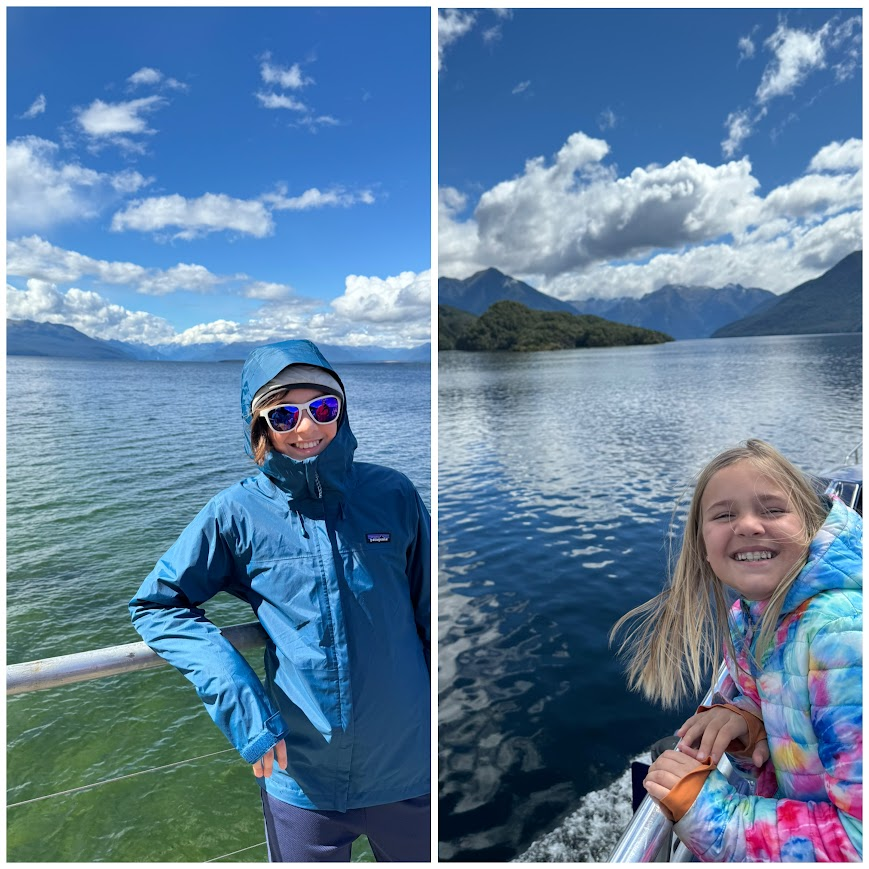
Approaching the cave entrance, you can see the water rushing out, a stark reminder of how the caves came to be in the first place. The walk into the cave requires some maneuvering, as the entrance required even Abby to duck down in some places. Moving deeper into the cave, you begin to see small dots of light on the roof of the cave; only a few, but a preview of the show to follow. After a bit of walking, we boarded a boat that was just wide enough to have two people sit back to back down the middle. The guide then turned off all the lights, and we ventured out into the darkness.
It’s always hard to imagine darkness like that, as it’s very difficult to escape the lights all around us today. This felt like moving down a tunnel with hundreds of tiny holes punched through the outside. As your eyes adjust, you’re able to make out more and more of the little bugs. The combination of the darkness, quiet, and tiny lights is truly remarkable.
Coming out of the caves, we had our reverie dulled by learning that they’re not worms, but maggots, they eat moths eyes first, and the little strands hanging from the ceiling are their vomit. Isn’t nature something?
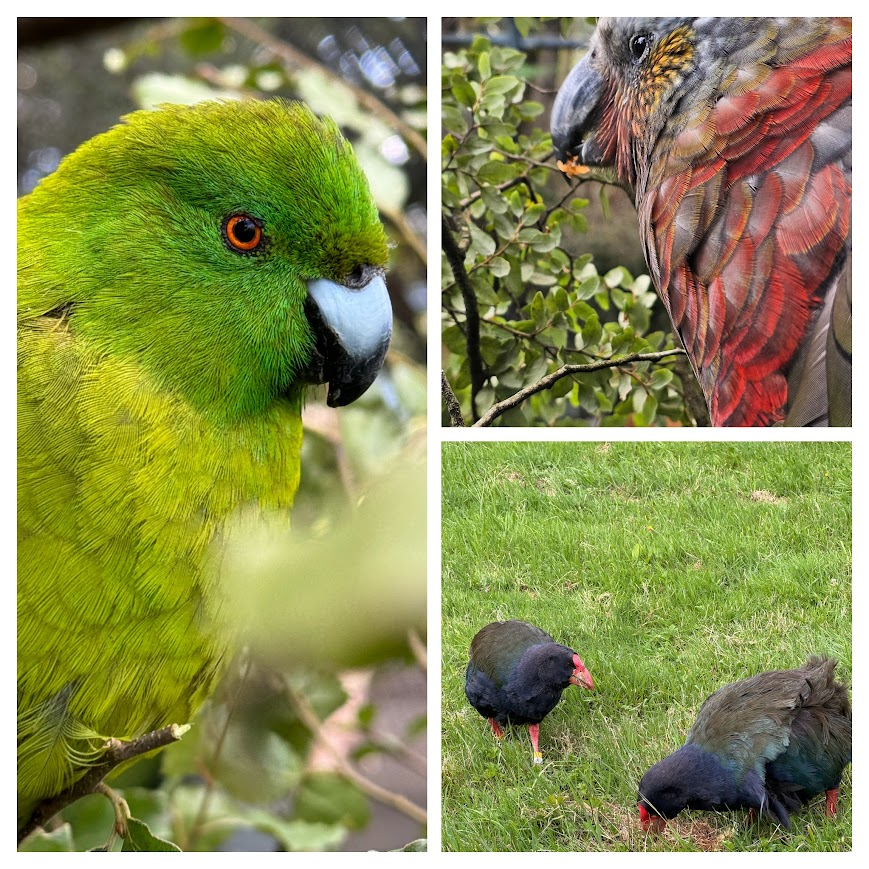
Caitlin:
Singapore was such an unexpected delight for us. I have to admit that stopping there wasn’t a high priority - I had vaguely thought it might be a fun spot to visit, but it’s never been at the top of my list of places to go. However, Singapore Airlines offers a free stopover in their country if you book a flight using points, so we decided to take advantage of that and stay for a while. I’m so glad we did! We all learned a lot about Singapore’s history (in part because we knew next to nothing at the start), and we very much enjoyed the ease of travel there. Like Japan, the public transportation is impressive, and a combination of English-language speakers and food around every corner makes it easy to explore new areas at leisure.
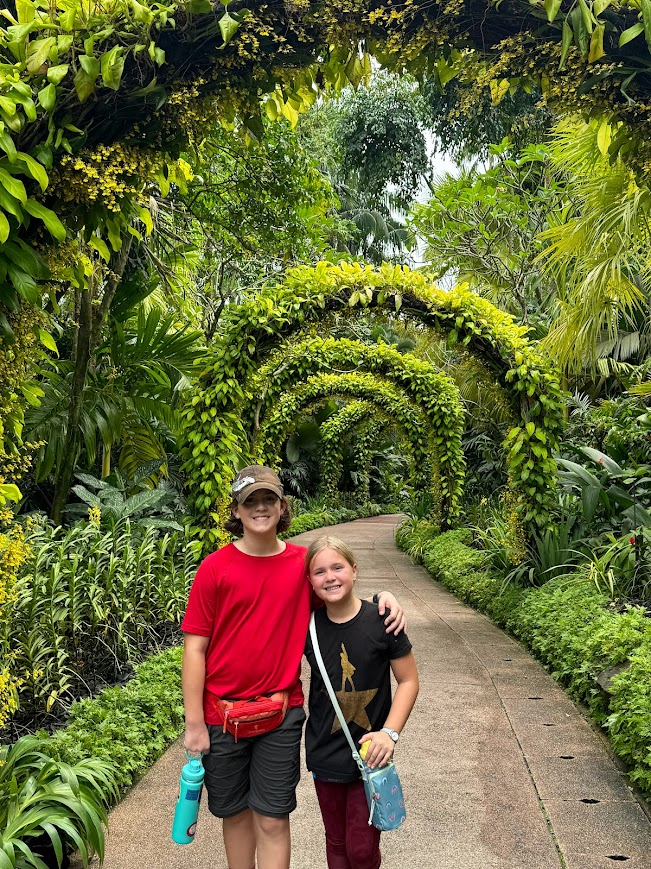
One of our favorite stops was when the kids and I went to the Singapore Botanic Gardens. After visiting Gardens by the Bay and having beautiful greenery/parks in all parts of the city, I was skeptical that the Botanic Gardens could offer a significantly different experience than what we’d already seen. I was wrong! It was amazing. The park is huge at 82 hectares, which is over 200 acres. It was Singapore’s first UNESCO World Heritage Site, and it’s filled with an incredible variety of plants. It has a ginger garden, a rainforest walk, a children’s garden, an ethnobotany garden and more. We spent most of the day there and didn’t see it all.
Every part of the park is open to the public except the National Orchid Garden; after being amazed by the free portions of the garden we were all excited to find out what makes the Orchid Garden special enough to require an admission fee, and we were not disappointed! It was enchanting. I’ve never seen such an amazing variety of orchid colors - some of them were so vivid that they almost appeared to be glowing. We snapped dozens of photos but it was impossible to capture the colors adequately. They even had a “celebrity garden” of special varieties that had been bred and named after visiting foreign dignitaries, including royalty, several US Vice Presidents, and others. There must be something I can do to get Singapore to name an orchid after me! I’ll have to think on that…
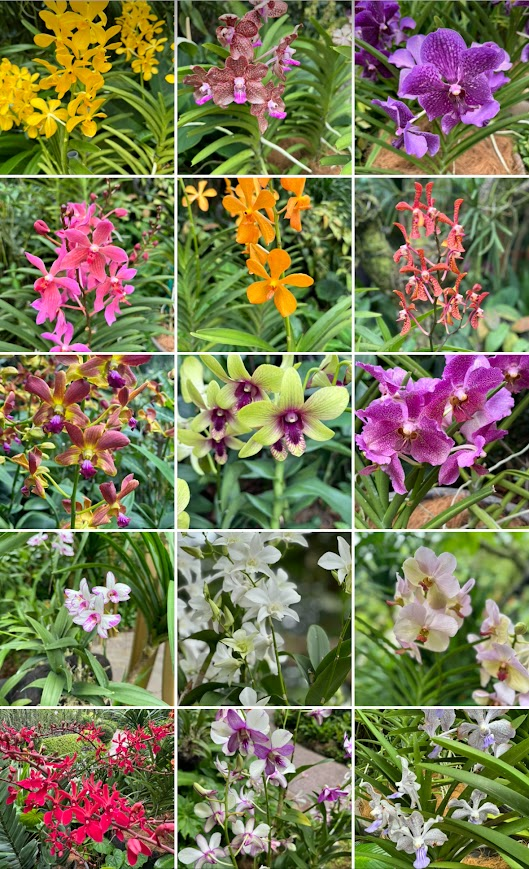
Despite our sadness to leave Singapore, we were all excited to come to New Zealand. I haven’t been here since I came with my parents and sisters over 30 years ago, and I’ve wanted to come back ever since. Some of you already know that we hoped to live for half a year in New Zealand before having those plans thwarted by the pandemic and eventually evolve into the multi-country adventure we’re on now. I was surprised to find myself feeling a bit emotional about our arrival; it feels like it’s been a long time coming. I’m so excited to explore this country again and get to share it with Sean and the kids!
James:
My subject this week is the Battlebox, a bunker dating from World War II that was used as a main base for the British command and where they made the momentous decision to surrender Singapore to Imperial Japan.
The main entrance juts out of a small hill, creating a patch of ugly in the middle of a beautiful expanse of greenery. It looks quite plain and industrial for such an important building. To get inside, you pass through two doors that are pure steel, albeit slightly rusted, with no less than eight separate locks that are only manipulatable from the inside for extra security. Its walls are meter-thick concrete, built to withstand any sort of bomb, and fuse boxes and ancient pipes are dotted around everywhere.
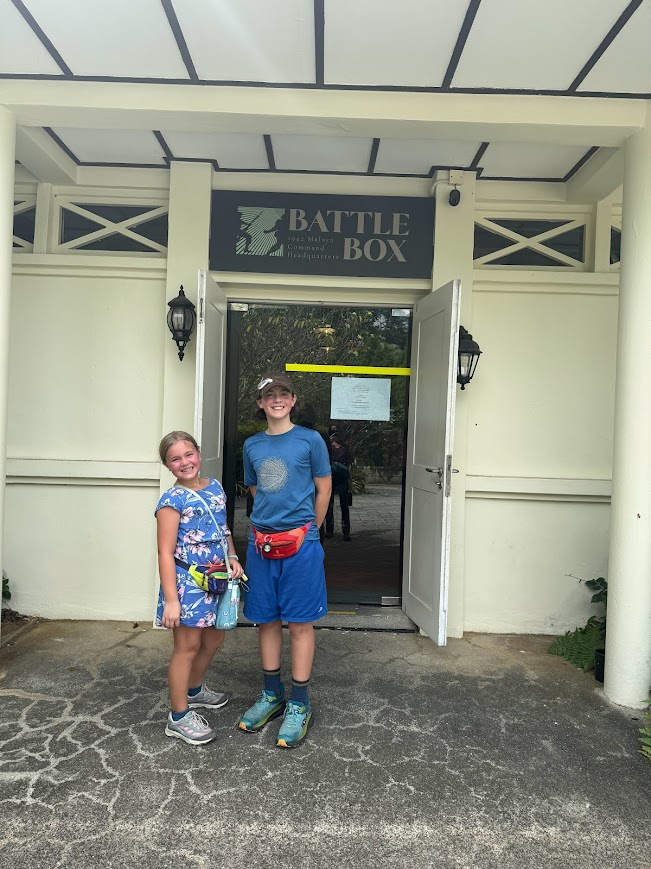
Rooms 1 through 4 were for communications. They were the telephone exchange room (where every call that came through to the bunker was routed to where it needed to go), the cipher office (where they decoded enemy transmissions), the signal office (where they controlled troop movements by sending, receiving, and translating Morse code messages), and finally the most important, the signal control, where they monitored everything that was going on, from phone calls to random soldiers to the advance of the Japanese.
All the rest of the rooms were for military planning and strategy and were some of the most important rooms in the fort. They included the room of the commander of the fortress, whose name was General Percival. He was under constant stress because they were losing battles. In fact, the British won so few battles that you could count their victories there on the fingers of one hand. The Japanese constantly pushed them back and back and back, decimating their troop complement and seriously lowering morale.
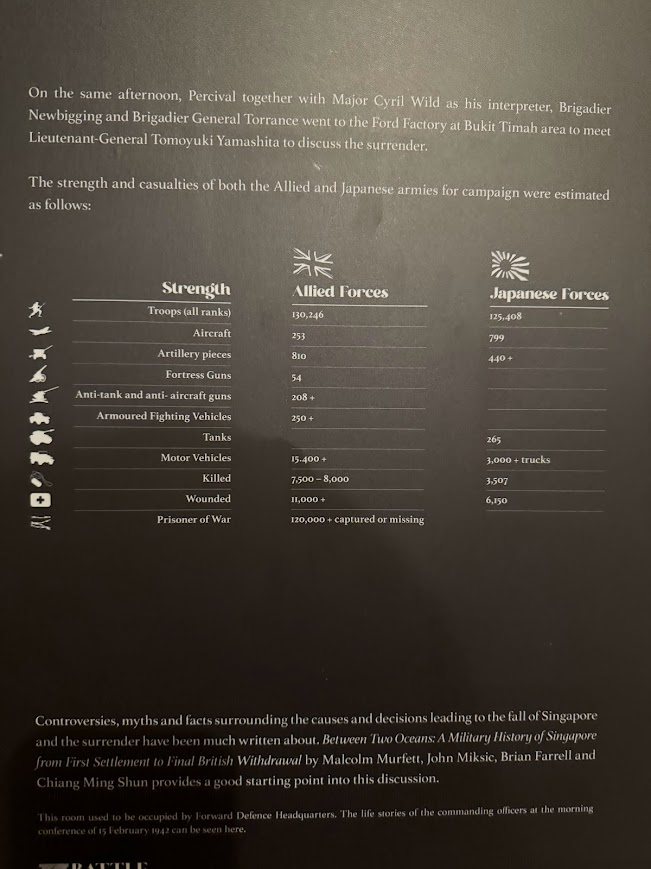
The fortress plotting room, where they made all of the important decisions, was where the idea to surrender Singapore was voiced aloud and eventually finalized and put into action. A massive influence on the decision was the perception that there was a water shortage that would only get worse if fighting continued. They did not want the people of Singapore to suffer further. They also could not rely on Britain for reinforcements or air support. The terms were negotiated by Gen. Percival and one of Japan's main generals. The verdict was unconditional surrender, which meant that the British were to pull out all of their forces and give the Japanese complete control.
The Battle of Singapore was the biggest loss in British military history, but I think it’s very moving that the biggest factor in the surrender was concern for the people of Singapore.
See you next week!
Sean, Caitlin, James and Abby
